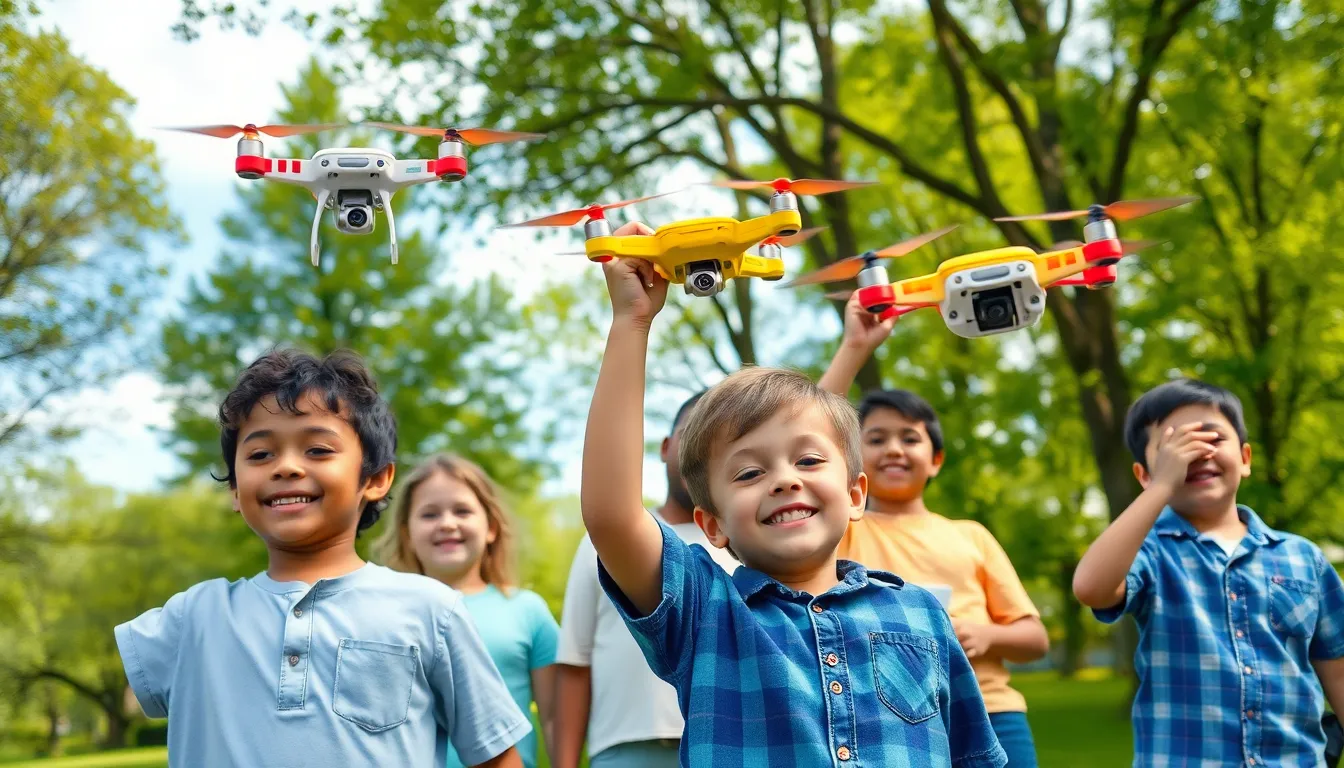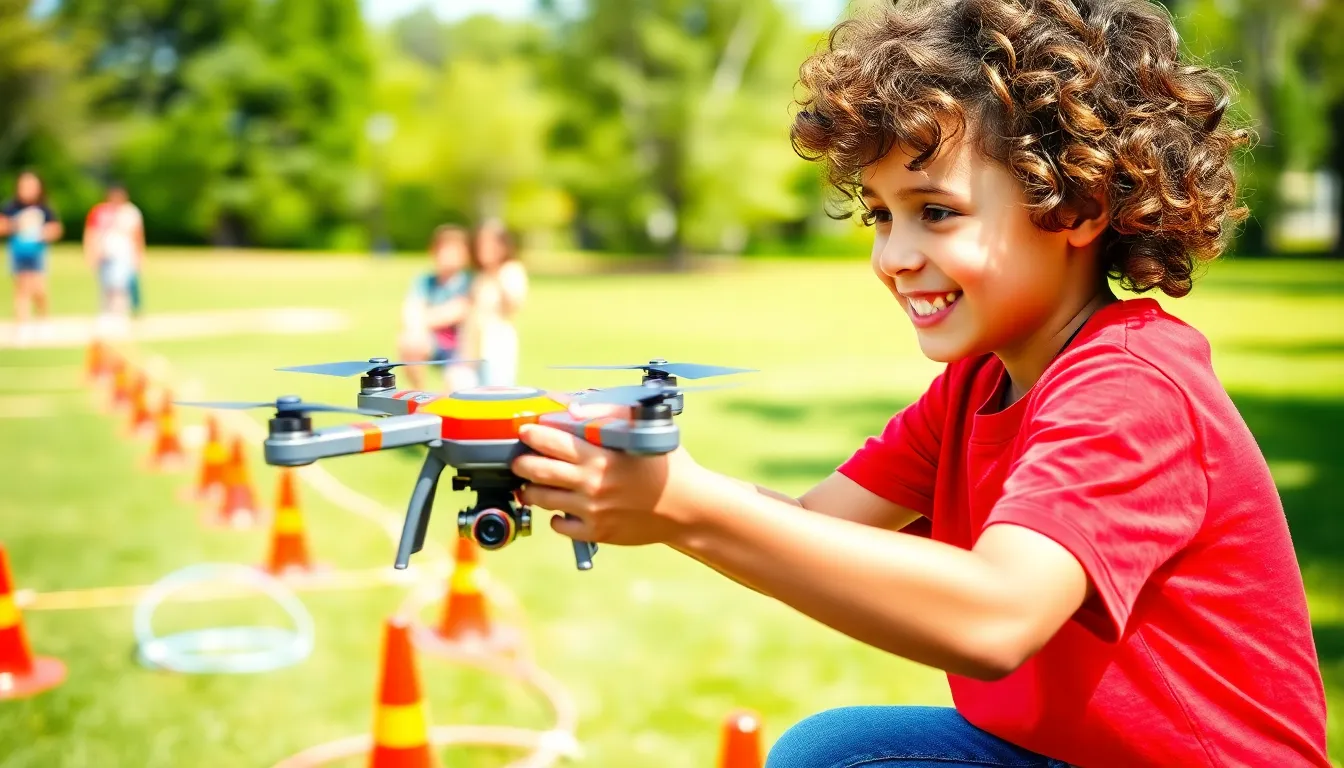Drones for children are the latest must-have gadget that’ll have kids soaring through the skies—well, at least in their imaginations. These flying marvels not only provide endless fun but also spark curiosity and creativity. Imagine your child piloting their very own drone, navigating through an obstacle course of garden gnomes and unsuspecting pets. Who wouldn’t want to witness that?
Table of Contents
ToggleOverview of Drones for Children
Drones for children have surged in popularity as engaging tools for play and education. These innovative gadgets combine elements of fun and learning, allowing kids to explore flight mechanics and develop coordination skills. Safety features enhance their appeal, ensuring that even younger users can enjoy flying without major risks.
Many models incorporate user-friendly controls, designed specifically for beginners, making operations straightforward. Parents appreciate the educational value that drones offer, including lessons in STEM (Science, Technology, Engineering, and Mathematics) concepts. They promote problem-solving skills as children navigate different flying scenarios or complete challenges.
Drones tailored for children typically weigh under 250 grams, which aids in maintaining safety standards and simplifies outdoor use. Various options come equipped with cameras, providing an opportunity for budding photographers to capture images from above. Features like automatic returns, altitude holds, and headless mode further enhance the flying experience.
Price points vary among models, ranging from budget-friendly under $50 to advanced options exceeding $200. Each category offers unique features that attract different age groups and skill levels. While newer pilots may gravitate toward simpler designs, more experienced kids often seek drones with advanced functionalities.
Drones designed specifically for children not only serve as entertaining gadgets but also foster creativity and technological skills. The combination of play and learning positions them as valuable tools for child development, extending their benefits far beyond mere amusement.
Benefits of Drones for Children

Drones designed for children provide numerous advantages that enrich their play and learning experiences.
Enhancing Learning and Creativity
Engaging with drones stimulates children’s curiosity about flight and technology. Kids explore fundamental principles of physics, such as lift and gravity, through hands-on experience. Imaginative play encourages creativity as children create scenarios for their drone flights. Learning opportunities extend beyond simple operation; using drones can enhance problem-solving skills as children navigate challenges while flying. Many drone models incorporate educational features that promote STEM concepts. Additionally, creative tasks—like capturing aerial photographs—allow children to express their artistic vision from unique perspectives.
Encouraging Physical Activity
Flying drones encourages kids to engage in outdoor activity. Children actively participate in setting up courses or moving to various locations for flights. This physical involvement improves coordination and balance while playing. Drones also promote teamwork and social interaction when children collaborate on flight missions. Parents often appreciate these benefits, as active play reduces sedentary behavior inspired by screen time. Outdoor flying encourages exploration of nature and develops an appreciation for the environment. By integrating movement with technology, drones make physical activity enjoyable and exciting for children.
Types of Drones Suitable for Kids
Drones designed for children come in various types, each providing unique features and experiences. Understanding these types helps parents select the best options for their kids.
Mini Drones
Mini drones offer compact designs ideal for indoor use. Their small size ensures safety during play, making them perfect for younger children. Often lightweight, many mini drones weigh less than 100 grams, promoting easy handling. User-friendly controls cater to beginners, allowing for quick mastery of flight basics. Furthermore, models often include features like one-key takeoff and landing, enhancing accessibility. Mini drones typically retail from $20 to $70, accommodating budget-conscious families, ensuring affordability while delivering fun.
Camera Drones
Camera drones provide budding photographers with exciting opportunities to explore aerial photography. Equipped with cameras, these drones allow kids to capture stunning images from unique perspectives. Many models feature simplified controls that promote easy operation for children. Camera drones frequently incorporate stability features, ensuring clear shots while flying. Price ranges for camera drones vary widely, starting around $50 and exceeding $200 for advanced models. The educational aspect of learning about photography techniques and videography further enriches the experience.
Safety Considerations
Safety remains a critical factor when selecting drones for children. Various elements play essential roles in ensuring a safe flying experience for young users.
Age Appropriateness
Age-appropriate drones foster a safer and more enjoyable flying experience. Many models specifically designed for children target specific age groups, typically recommending ages 8 and up. Drones under 100 grams reduce the risk of injury in case of a crash. Manufacturers often include safety features like propeller guards, making them suitable for younger pilots. Parents should check for age recommendations to ensure the drone aligns with their child’s maturity and skill level. The right choice enhances both safety and enjoyment.
Supervision and Guidelines
Supervision is crucial while children operate drones. Adults should oversee flights, especially for younger users, to ensure compliance with safety protocols. Setting clear guidelines about flying environments helps prevent accidents. Choosing open outdoor spaces reduces the risk of collisions with people or property. Establishing rules regarding distance and altitude maintains safe flying practices. Involvement fosters a supportive learning environment and encourages responsibility. Regularly reviewing safety procedures reinforces safe behavior while flying drones.
Tips for Choosing the Right Drone
Selecting the ideal drone for children involves assessing various factors that enhance safety and enjoyment. Parents should consider features that cater to their child’s skill level and interests.
Features to Look For
User-friendly controls ensure kids can easily operate the drone without frustration. Safety features like propeller guards minimize injury risks during flight. Lightweight designs, preferably under 100 grams, allow for safe indoor and outdoor use. Easy charging and durable construction extend the drone’s longevity. Models equipped with cameras offer an added layer of fun and creativity, enabling children to explore photography. Look for drones with stable flight capabilities, enhancing the overall flying experience.
Recommended Models
Each of these models meets distinct needs for young pilots. The Holy Stone HS210 Mini Drone stands out for its compact size and affordability, retailing around $30. Ideal for beginners, it includes features like one-key takeoff and altitude hold. The Snaptain SP350, priced at $50, integrates a camera for aerial shots and has voice control capabilities. Perfect for slightly older kids, this model combines fun with creative exploration. For a more advanced option, the Potensic D80, at approximately $199, offers GPS functionality and 2K camera quality, suitable for budding adventurers and aspiring photographers alike.
Drones for children represent a unique blend of fun and education. These gadgets not only entertain but also inspire curiosity and creativity. As kids navigate the skies they develop essential skills in coordination and problem-solving while engaging with technology in a hands-on way.
With a variety of options available parents can easily find models that suit their child’s age and skill level. Safety features ensure a worry-free experience while encouraging outdoor play and social interaction. By choosing the right drone parents can foster a child’s interest in STEM and promote active lifestyles.
Ultimately drones serve as powerful tools for development enriching children’s lives beyond simple amusement. Embracing this trend can lead to exciting adventures and valuable learning experiences for the next generation.


